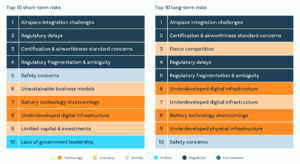Current developments in the AAM industry, such as regulatory advancements in multiple regions, large funding rounds and new strategic partnerships between legacy aerospace organisations and AAM start-ups, amongst others, led Orbit Management Services – a Swiss-based professional service boutique – to survey more than 150 executives and experts across the globe.
Orbit gathered exclusive insights into experts’ perceptions of the developments in the AAM industry and its complex risk landscape for their AAM Risk Report 2023, offering valuable insights for stakeholders involved in shaping the future of the AAM industry.
The results further provide a new perspective for everybody working, investing or just following the AAM space.
Here are the top five takeaways from the AAM Risk Report 2023:
1. AAM industry outlook: Strongest outlook for logistics and enterprise applications
The AAM industry represents a disruptive force, promising revolutionary changes in transport and logistics. While there may be some scepticism and uncertainty in the short term, the entire industry and all sub-sectors are expected to experience positive developments and opportunities in the long term.
By 2033, especially logistics and enterprise applications are poised for significant growth. These areas show the most optimistic outlook, even with challenges such as regulatory delays and battery technology limitations.
2. Regulatory risks dominate in the short and long term
The AAM industry’s risks are diverse. yet regulatory issues are perceived as the biggest challenge. both in the short and long term. Key risks include battery technology limitations, airspace integration challenges, regulatory delays, and certification and airworthiness standard concerns.
Addressing these challenges requires technological and regulatory innovation and effective collaboration between regulatory bodies and industry leaders.
3. Lack of government support, unsustainable business models and increasing competitive pressures
Other critical risks identified in the report include a lack of government support, unsustainable business models. and growing competition within the AM industry.
These factors underscore the need for strategic planning and support from diverse stakeholders to ensure sustainable growth and innovation within the field as they help address technological and regulatory challenges, ensuring long-term growth and economic sustainability.
4. Need for balanced risk management
Managing the different risks is essential for informed decision-making and fostering a resilient ecosystem. Orbit’s AAM Risk Report emphasises the importance of balanced risk management within the AAM industry. Risk management responsibilities are generally split between the private sector (focusing on technology and business) and the public sector (focusing on policy, regulation, and leadership), requiring cooperative action. Stakeholders must address risks proactively to ensure the growth and resilience of the entire ecosystem. This involves enhancing risk identification, investing in risk readiness, and fostering collaboration as part of a unified strategy.
5. Collaboration and strategic partnerships between the public and private sectors
Building on the need for a cooperative approach in risk management, both private and public sectors should engage in strategic partnerships to address an array of concems. This encompasses technological development, business and policy challenges, regulatory compliance, infrastructure planning, and insurance matters.
Collaboration within the industry, across sectors, and at the international level is crucial for collective resilience. Stakeholders must align and collaborate for a sustainable and resilient AAM ecosystem, recognizing that a coordinated approach will be vital in navigating the complex risk landscape.
This report shows that while the road to realising AAM’s potential is fraught with challenges, it also presents exciting opportunities. Success in this dynamic field will likely depend on collaboration and innovation, a clear understanding of risks, and robust strategies to navigate them. As the industry evolves, this report offers a crucial roadmap for those striving to drive growth and innovation in the advanced air mobility landscape.
You can access the full risk report free of charge here.
Subscribe to the FINN weekly newsletter
You may also be interested in:
Industry embraces sustainable future with latest AAM technology

